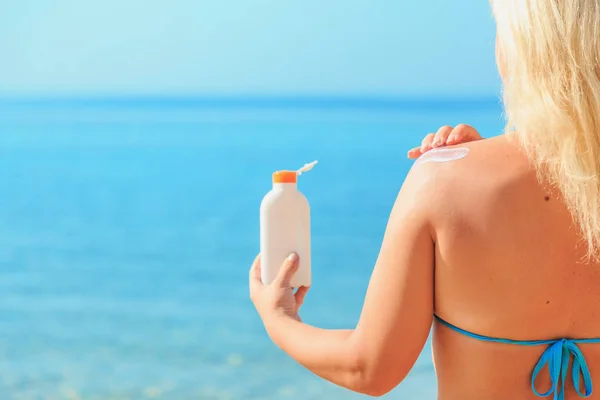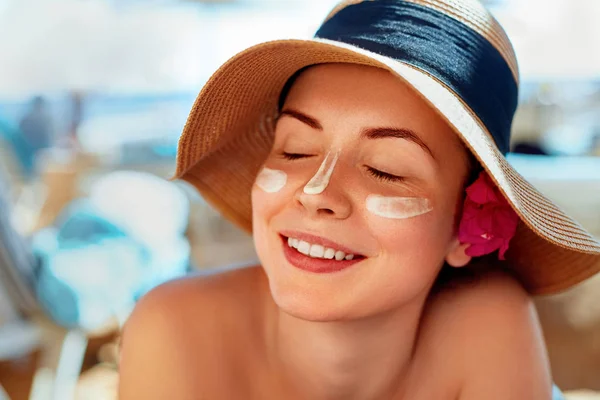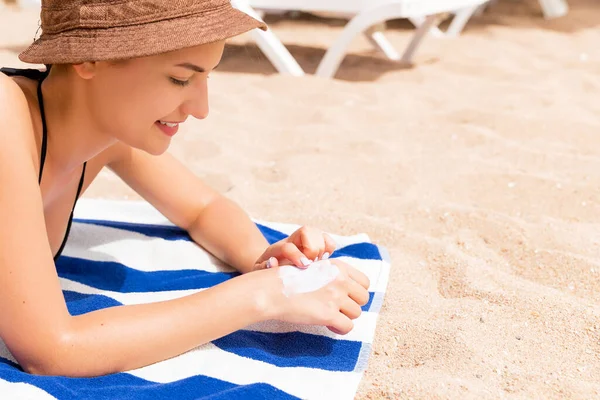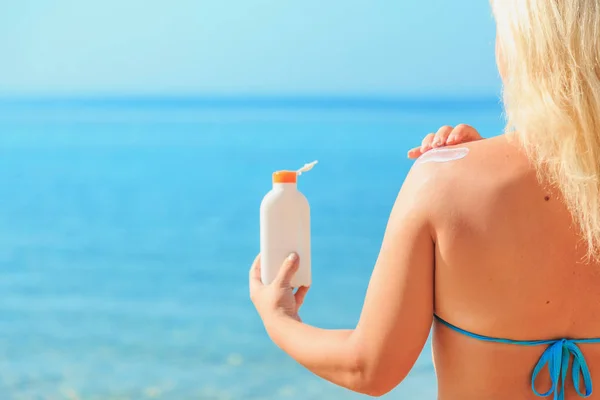When To Apply Sunscreen In Skincare Routine: Always apply sunscreen as the final step in your morning skincare routine, after moisturizer but before makeup, to ensure optimal protection against harmful UV rays.
Applying sunscreen is a crucial step in any skincare routine. It should be applied as the last step in your morning skincare regimen.
Sunscreen protects your skin from harmful UV rays, preventing sunburn, premature aging, and skin cancer. Apply it generously and evenly, covering all exposed areas. Reapply every two hours, especially if you’re spending time outdoors.

When To Apply Sunscreen In Skincare Routine
Importance of Sunscreen in Skincare
Incorporating sunscreen into your daily skincare routine is essential for maintaining healthy skin. Sunscreen acts as a barrier, shielding your skin from the damaging effects of UVA and UVB rays. These rays can lead to various skin issues, including hyperpigmentation, fine lines, and wrinkles.
By applying sunscreen, you can prevent these problems and keep your skin looking youthful. Many dermatologists emphasize the importance of using a broad-spectrum sunscreen with an SPF of at least 30.
This level of protection ensures that your skin is adequately guarded against the sun’s harmful effects. Remember, even on cloudy days, UV rays can penetrate through the clouds and cause damage, so applying sunscreen should be a daily habit.
How to Apply Sunscreen Correctly
Applying sunscreen correctly is vital to ensure maximum protection. Start by cleansing your face with a gentle cleanser, followed by your usual serums and moisturizers. Once your skin is prepped and hydrated, apply a generous amount of sunscreen.
Most experts recommend using about a nickel-sized amount for your face and more for other exposed areas like your neck, ears, and hands. Make sure to apply it evenly and allow it to absorb into your skin before applying makeup.
Sunscreen should be reapplied every two hours, especially if you’re swimming or sweating. Opt for a water-resistant formula if you plan to be active or spend time in water.
Best Sunscreen Practices
Choosing the right sunscreen can make a significant difference in your skincare routine. Look for sunscreens labeled as “broad-spectrum” to ensure they protect against both UVA and UVB rays.
It’s also important to choose a sunscreen that suits your skin type. For oily or acne-prone skin, a lightweight, non-comedogenic sunscreen is ideal. Those with dry skin may benefit from a more hydrating formula.
Mineral sunscreens, containing zinc oxide or titanium dioxide, are great for sensitive skin as they are less likely to cause irritation. Additionally, consider using a sunscreen with added antioxidants to further protect your skin from environmental damage.
In summary, applying sunscreen should be the final step in your morning skincare routine. It protects your skin from UV rays, prevents premature aging, and reduces the risk of skin cancer.
Use a broad-spectrum sunscreen with at least SPF 30, apply it generously, and reapply every two hours for optimal protection. Choose a sunscreen that matches your skin type and lifestyle for the best results.
When To Apply Sunscreen In Skincare Routine
In the quest for flawless skin, knowing when to apply sunscreen in your skincare routine can make all the difference. While many understand the importance of SPF for protecting against harmful UV rays, integrating it effectively into your daily regimen is key to maximizing its benefits.
Whether you’re a skincare novice or a seasoned aficionado, mastering the timing of your sunscreen application can enhance your skin’s health and radiance, preventing premature aging and shielding against skin cancer. Let’s dive into the science and strategy behind the optimal placement of sunscreen in your skincare ritual.

Understanding Sunscreen
Types of Sunscreens
Sunscreen is essential for protecting your skin from harmful UV rays. There are two main types: physical (mineral) sunscreens and chemical sunscreens.
Physical (Mineral) Sunscreens
Physical sunscreens, also known as mineral sunscreens, contain natural ingredients like zinc oxide and titanium dioxide. These ingredients work by creating a protective barrier on the skin that reflects UV rays away from the body.
Many people prefer physical sunscreens because they are less likely to cause skin irritation and are effective immediately upon application.
Chemical Sunscreens
Chemical sunscreens contain active ingredients such as oxybenzone, avobenzone, and octinoxate. These chemicals absorb UV rays and convert them into heat, which is then released from the skin. Chemical sunscreens are often preferred for their lightweight, non-greasy feel and their ability to blend seamlessly into the skin.
SPF Ratings and Their Significance
Understanding SPF ratings is crucial for choosing the right sunscreen for your skin type and sun exposure.
Definition of SPF
SPF stands for Sun Protection Factor. It measures a sunscreen’s ability to protect against UVB rays, the primary cause of sunburn. Higher SPF numbers indicate greater protection. For example, SPF 30 blocks approximately 97% of UVB rays, while SPF 50 blocks about 98%.
Choosing the Right SPF for Different Skin Types and Conditions
Selecting the appropriate SPF depends on your skin type and the conditions you’ll be exposed to. Fair-skinned individuals or those with a history of skin cancer should opt for higher SPF ratings, like SPF 50 or above. For everyday use, SPF 30 is usually sufficient. However, when spending extended time outdoors, higher SPF provides better protection.
Skincare Routine Basics
A proper skincare routine is essential for maintaining healthy, glowing skin. Here are the common steps involved:
Common Steps in a Skincare Routine
Cleansing
Start with a gentle cleanser to remove dirt, oil, and makeup. Cleansing prepares your skin for the next steps by ensuring it’s clean and fresh. Keywords: facial cleanser, clean skin, remove impurities.
Toning
Apply toner to balance the skin’s pH levels. Toning helps to tighten pores and refresh the skin. Keywords: toner, pH balance, skin refreshment.
Serum Application
Use a serum to target specific skin concerns like hydration, aging, or pigmentation. Serums are packed with active ingredients that penetrate deeply. Keywords: facial serum, skin treatment, active ingredients.
Moisturizing
Lock in moisture with a good moisturizer. Moisturizing keeps your skin hydrated and creates a protective barrier. Keywords: moisturizer, hydration, skin barrier.
Importance of Layering in Skincare
Layering skincare products correctly is crucial for maximum effectiveness.
Absorption rates of different products
Different products have varying absorption rates. Apply lighter products first to ensure they penetrate deeply. Keywords: product absorption, skincare layers, deep penetration.
Correct order of application
The order of application matters. Start with the thinnest consistency and move to the thickest. This helps each product to be absorbed properly. Keywords: skincare order, application sequence, optimal absorption.
When to Apply Sunscreen in Your Skincare Routine
General Rule of Thumb
Sunscreen as the Final Step Sunscreen should always be the last step in your morning skincare routine. This ensures maximum protection from harmful UV rays. Applying it last creates a barrier that shields your skin from sun damage.
Exceptions to the Rule Sometimes, you may use makeup with SPF. In these cases, apply sunscreen before your makeup. This doubles your sun protection and helps maintain your skin’s health. Remember, relying solely on SPF makeup may not provide sufficient protection.
Detailed Step-by-Step Guide
Morning Routine a. Cleanser Start with a gentle cleanser. This removes dirt and excess oil, prepping your skin for the next steps.
Toner Follow with a toner to balance your skin’s pH. Toners also help in better absorption of subsequent products.
Serum Apply a serum targeting your specific skin concerns. Serums penetrate deep into the skin, providing essential nutrients.
Moisturizer Use a moisturizer to hydrate your skin. Hydrated skin is more resilient and better protected against environmental stressors.
Sunscreen Finish with a broad-spectrum sunscreen. This protects your skin from both UVA and UVB rays. Sunscreen is crucial to prevent premature aging and reduce the risk of skin cancer.
Evening Routine
Why Sunscreen is Not Needed at Night Sunscreen is unnecessary at night because there is no exposure to UV rays. Instead, focus on repairing your skin from daytime damage.
Focus on Repair and Hydration At night, use products that repair and hydrate your skin. Night creams, serums, and treatments are ideal for skin regeneration and hydration.
Special Considerations
Skin Type and Sunscreen
Oily Skin
When choosing sunscreen for oily skin, opt for lightweight, non-comedogenic formulas. These sunscreens won’t clog pores and help prevent breakouts. Look for keywords like “oil-free,” “matte finish,” and “lightweight sunscreen.”
Dry Skin
For dry skin, hydrating sunscreens with moisturizing properties are essential. They prevent dryness and flakiness while providing sun protection. Common terms include “hydrating,” “moisturizing sunscreen,” and “nourishing SPF.”
Sensitive Skin
Sensitive skin benefits from mineral sunscreens to avoid irritation. These sunscreens often contain zinc oxide or titanium dioxide. Related phrases include “hypoallergenic,” “gentle sunscreen,” and “mineral SPF.”
Sunscreen and Makeup
Layering Makeup Over Sunscreen
Apply sunscreen before makeup for optimal protection. Ensure the sunscreen is fully absorbed before layering makeup. Popular phrases are “makeup over sunscreen,” “foundation over SPF,” and “layering products.”
Using Makeup Products with SPF
Makeup products with built-in SPF offer added protection. They are convenient and effective. Search for “SPF foundation,” “sunscreen makeup,” and “BB cream with SPF.”
Reapplication Throughout the Day
Reapplying sunscreen throughout the day is crucial for ongoing protection. Use setting sprays or powder sunscreens for easy reapplication.
Reapplication of Sunscreen
Importance of Reapplication
Sunscreen Breakdown Over Time
Sunscreen protection diminishes over time. UV rays break down active ingredients. Continuous exposure reduces effectiveness. Reapplying ensures consistent protection.
Effects of Sweat and Water Exposure
Sweat and water wash away sunscreen. Activities like swimming or exercising accelerate this. Waterproof sunscreen still needs reapplication. Always reapply after sweating or swimming.
Practical Tips for Reapplication
Frequency (Every 2 Hours)
Apply sunscreen every 2 hours. More frequent application needed if sweating or swimming. This maintains optimal protection from UV rays.
Methods (Sprays, Powders, Sticks)
Use various methods for reapplication. Sprays, powders, and sticks offer convenience. Choose based on your skin type and activity level. Sprays cover large areas quickly. Powders are great for oily skin. Sticks work well for targeted application.
Reapplying Over Makeup
Reapply sunscreen over makeup without smudging. Use sunscreen sprays or powders. Gently dab powder onto your face. Sprays can be applied lightly over makeup. This keeps your skin protected and makeup intact.
Common Myths and Misconceptions
Sunscreen and Vitamin D
Addressing Concerns About Vitamin D Deficiency
A widespread myth suggests sunscreen usage causes vitamin D deficiency. Sunscreen does reduce UV exposure, which can impact vitamin D synthesis. However, you can still get enough vitamin D while using sunscreen by spending short periods in the sun or through dietary supplements.
Dermatologists recommend applying sunscreen to protect against skin cancer and other UV-related skin damage. Contrary to the myth, balanced sun exposure and a healthy diet can maintain adequate vitamin D levels without compromising skin health.
Indoor Protection
Necessity of Sunscreen Indoors and During Cloudy Days
Many people believe sunscreen is unnecessary indoors or on cloudy days. This misconception overlooks that UV rays penetrate windows and clouds. UVA rays, which contribute to skin aging and cancer, are present even on overcast days and can pass through glass.
Dermatologists stress the importance of daily sunscreen application, regardless of the weather or indoor setting, to ensure consistent protection against harmful UV radiation. Using sunscreen daily maintains long-term skin health and prevents damage from unexpected UV exposure.
Expiry Dates and Effectiveness
Shelf Life of Sunscreens
A common myth is that sunscreen never expires. In reality, sunscreens have a shelf life, typically around three years. Using expired sunscreen reduces its effectiveness, increasing the risk of sunburn and skin damage. Checking the expiration date on your sunscreen bottle ensures you’re getting the maximum protection.
How to Tell If a Sunscreen Has Expired
Expired sunscreen may show changes in texture, color, or smell. If your sunscreen becomes clumpy, separates, or smells off, it’s time to replace it. Storing sunscreen in a cool, dry place can help maintain its effectiveness over time. Ensuring your sunscreen is within its shelf life is crucial for optimal UV protection.

FAQs
At what step should I apply sunscreen in my skincare routine?
Sunscreen should be the final step in your morning skincare routine. After cleansing, toning, and moisturizing, apply sunscreen to protect your skin from UV damage. If you use makeup, apply it after the sunscreen has fully absorbed.
Can I apply sunscreen before my moisturizer?
It’s best to apply sunscreen after your moisturizer. Moisturizers can create a barrier that helps keep your skin hydrated, and applying sunscreen last ensures that it forms an even protective layer on top of all your skincare products.
How long should I wait between applying my moisturizer and sunscreen?
Wait about 5-10 minutes after applying your moisturizer before applying sunscreen. This allows the moisturizer to fully absorb into your skin, ensuring that the sunscreen can create an even and effective protective barrier.
Do I need to reapply sunscreen if I’m wearing makeup?
Yes, you should reapply sunscreen every two hours, even if you’re wearing makeup. To make reapplication easier, consider using a sunscreen spray or powder that can be applied over makeup.
Is it necessary to wear sunscreen indoors?
Yes, it’s important to wear sunscreen indoors as well. UV rays can penetrate windows and still cause skin damage. Additionally, blue light from screens can contribute to skin aging, making daily sunscreen application beneficial even when staying indoors.
Can I use a moisturizer with SPF instead of a separate sunscreen?
While a moisturizer with SPF is better than no protection at all, a dedicated sunscreen typically offers more consistent and reliable protection. If you choose to use a moisturizer with SPF, make sure it provides broad-spectrum protection and has an SPF of at least 30.
Should I apply sunscreen if my foundation contains SPF?
Yes, you should still apply a separate sunscreen even if your foundation contains SPF. The amount of foundation typically used is often not enough to provide adequate sun protection. Apply sunscreen as a base layer before applying your makeup.
How much sunscreen should I apply to my face?
You should apply about a nickel-sized amount of sunscreen to your face. Ensure you cover all exposed areas, including your ears, neck, and the back of your hands.
Is sunscreen necessary on cloudy days?
Absolutely! Up to 80% of UV rays can penetrate clouds, so it’s essential to wear sunscreen even on cloudy or overcast days to protect your skin from UV damage.
Can I skip sunscreen if I’m only outside for a short time?
No, you should apply sunscreen every day regardless of the time you spend outside. UV exposure can accumulate over time and contribute to skin damage and aging. Consistent use of sunscreen helps protect your skin in the long term.
Conclusion
Incorporating sunscreen into your daily skincare routine is essential for maintaining healthy skin and protecting it from the harmful effects of UV rays. The optimal time to apply sunscreen is as the final step in your morning skincare regimen, after moisturizing but before makeup.
This ensures that your skin receives maximum protection without interference from other products. Consistent use of sunscreen helps prevent premature aging, sunburn, and reduces the risk of skin cancer. By making sunscreen application a daily habit, you are taking a crucial step in preserving your skin’s health and longevity.


